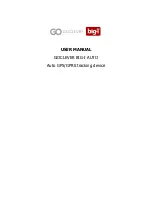
your position is our focus
How to recognize a successful calibration
To
see
the
progress
of
the
DR
calibration,
the
EKFSTATUS
percentage
values
can
help
(compare
with
Figure
13).
Accuracy
of
Bias
of
Gyro
[%]
Accuracy
of
Speed
Scale
Factor
[%]
Accuracy
of
Scale
Factor
of
Gyro
[%]
85%
95%
>65%
Phase I:
Gyro
Offset
calibration
Phase II:
Scale
Factor
Tick
calibration
Phase III:
Scale
Factor
Gyro
calibration
Phase IV:
Ongoing
Temperature
Compensation
Calibration
Ongoing fine calibration
Initial Calibration
Figure 14: Phases of EKF calibration
!
Note
The
values
above
do
not
tell
anything
about
the
quality
of
the
calibration,
but
only
about
the
progress
of
the
calibration
process.
Consequences of a bad/wrong calibration procedure
The
ANTARIS
®
DR
Technology
needs
well-calibrated
sensors
to
have
optimal
performance.
A
poorly
calibrated
system
will
report
wrong
positions
and
headings
during
GPS
loss.
Also
the
performance
is
degraded
during
good
GPS
performance,
as
the
position
output
with
good
GPS
performance
will
be
combined
with
the
poor
data
from
the
sensors
(refer
to
Figure 4
).
As
long
as
the
miscalibration
is
minor
(e.g.
change
of
tires
from
summer
to
winter
tires),
the
system
will
recover
itself.
If
the
miscalibration
leads
to
a
‘sensor
integrity
check
error’
(the
receiver
reports
GPS
only
solutions/
see
also
Section
3.1.1.2),
a
reset
of
the
calibration
data
and
new
initial
calibration
is
required.
3.1.5 Storage of Parameters
To
maintain
a
high
degree
of
dead
reckoning
navigation
accuracy,
all
dynamic
DR
calibration
parameters
are
saved
in
a
common
configuration
section
(see
Section on Receiver Configuration in Antaris
®
4 System Integration
Manual [5]
for
further
information).
These
are:
•
Gyro
offset
and
scaling
factor
•
Gyro
temperature
compensation
information
•
Odometer
scaling
factor
All
data
is
dynamically
updated
and
stored
periodically
during
periods
of
good
GPS
reception.
In
addition
all
data
is
stored
to
the
non-volatile
RAM,
allowing
continued
dead
reckoning
when
a
vehicle
has
been
parked
and
shut
down
at
an
obstructed
site,
for
example
an
indoor
or
underground
car
park.
At
startup,
the
previously
stored
heading
will
be
retrieved
in
order
to
continue
accurate
dead
reckoning
navigation
in
the
right
direction
until
sufficient
number
of
satellites
is
visible
again
to
calculate
an
absolute
position
fix.
LEA-4R
/
TIM-4R
-
System
Integration
Manual
/
Reference
Design
Receiver
Description
GPS.G4-MS4-05043
Page 23















































